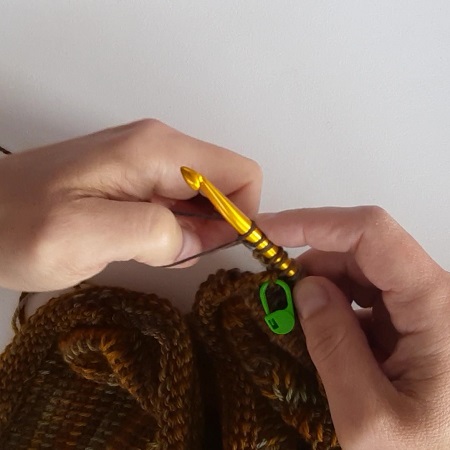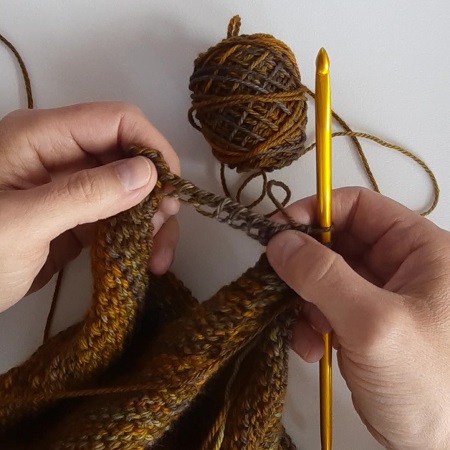There are several ways to cast on stitches in Tunisian crochet. I use different methods depending on the type of projects I work on. In this article, I show you how I do the slip knot cast on.

Traditionally we start a Tunisian crochet project with chains. But there are many other different ways to start a Tunisian crochet work. What matters is that you create loops on your hook to create a foundation row. See the different types of foundation rows I have documented so far on my website page called: “Foundation rows and cast on techniques“.
Warning: I only use the slip knot cast on technique to add stitches under the arms of my top down sweater projects. That’s why in the video I made (futher below), you see a seamless raglan top down sweater to illustrate the slip knot cast on technique. You can use the slip knot cast on technique in many other cases. In this article, I tell you why I personally don’t do this.

Slip knot cast on
A slip knot is usually the first thing you make when you start any kind of crochet project and that includes Tunisian crochet. It’s the first loop that is on your hook before you start anything else.
If you don’t know how to make a slip knot, I recommend the video made by GarnStudio. You can make a slip knot in many different ways, but the end result is always the same: you have a loop on your hook the size of which you can adapt, make wider or tighter, depending on the size of your hook.
The slip knot cast on is nothing else than a series of slip knots, made one after the other, and that you consider as stitches added on your hook. This technique has pros and cons. Keep all of them in mind before you use the slip knot cast on technique.
Pros of the slip knot cast on technique
The huuuuuge advantage of the slip knot cast on technique, in my humble opinion, is that it’s easy and quick. It’s basically the main reason why I use it to add stitches in my Tunisian crochet top down projects to shape the underarm sections.
Other big advantage: you work with the same yarn thread. No need to use another thread to make chains into which you’ll pick up loops. I find it particularly nice with color works.
Also, you use the same hook. You don’t have to leave anything on hold and grab another hook to make chains or any other knitting techniques to cast on new stitches. You just keep on adding loops with the same yarn thread and hook. That’s really handy.
Cons of the slip knot cast on technique (must read!!!)
The reason why I never use the slip knot cast on technique for anything else than adding a few stitches to shape the underarm section of my top down sweaters is simple: slip knots are not stable. And not pretty (but that’s only my personal perception).
A slip knot is just a knot that you create at the base of a loop around your hook. It allows you to adjust the size of this loop and you really have to make sure this loop on your hook is not too loose or too tight. It’s really hard to keep an even tension across all loops added on your hook with the slip knot cast on technique.
This tension thing is really important. If you make your loops too wide, you’ll end up with big holes on the edge of your work. If you make your loops too tight, you’ll have a hard time making the return pass and, even worse, the following forward pass to pick up new loops into really tight slip knots.
I’m not a big fan of edges created with the slip knot cast on technique. But all in all, used to add stitches under the arms of a top down garment, who cares, really? You don’t see the edges. Even more so if you add sleeves to your garment.
How to cast on several slip knots on your hook?
Here is what the slip knot cast on technique looks like when you have worked the return pass. Not really neat, hey? But since we usually add a bind off row or a sleeve on it, nobody will see it.

Usually I take the time to make a photo tutorial. But this year I promised I would make more videos. So I decided it would be better to illustrate how I make a slip knot cast on in a video. It’s in French. But I made really slow movements to show the technique.
In this video I use one of my works in progress, made with a double-ended hook. It’s a seamless top down raglan top with a wide neckline. It does not matter whether you use a double-ended or single-ended Tunisian crochet hook. The slip knot cast on technique works in both cases.
Want to make a seamless top down sweater in Tunisian crochet?
See my patterns on Ravelry.
